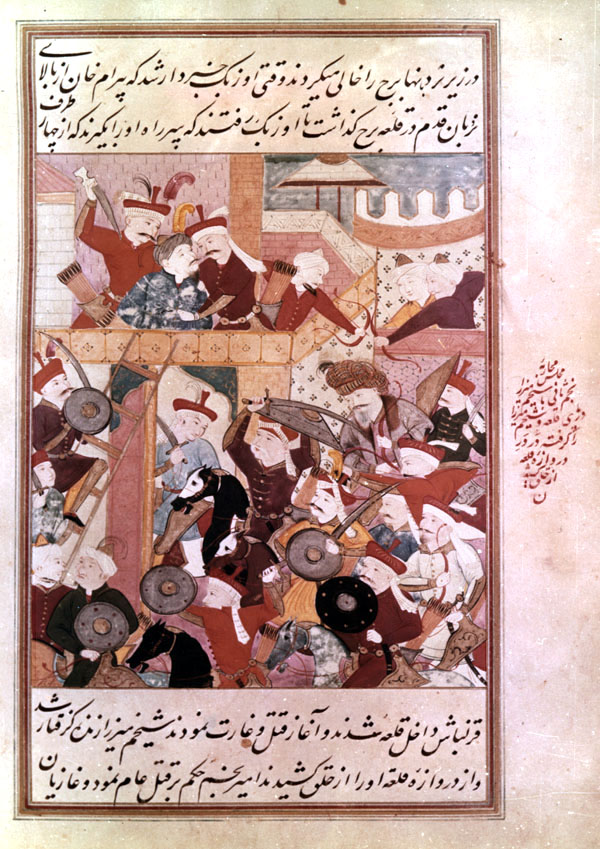Najm Sāni Hangs Šayḵam Mirzā at the Gate of Qarši
In the year 918/1512, Emir Najm-e Sāni, the vakil-e divān-e aʿlā, whose power and influence at the court was considerable, was appointed by Esmāʿil to set in order the affairs of Khorasan and to deal with the Uzbeg menace. Without specific orders or instructions from the shah, Najm-e Sāni resolved on the subjugation of Transoxiana, and together with the governor of Herat and the great emirs of Khorasan, crossed the Oxus. At Qarši, Emir Najm gave the orders for a general massacre, in which Šayḵam Mirzā and a large number of the population were put to death. Eskandar Monshi records the number at 15,000 people, but this text states it to be 4,000 to 5,000.
The scene depicted is at the walls of the city of Qarši. On the upper level of the wall Šayḵam Mirzā (or Shaykh Mirzā-ye Uzbeg as he is called by Monshi) can be seen bound with a rope and held captive at knife point by two qezelbāš troops in preparation for hanging. Below is a mass of heads, horses, and weapons, which portray not so much a battle as an onslaught of Safavid troops. A total of nine qezelbāš can be singled out advancing from right to left, wielding swords, shields, and bows. Two others with sword in hand are scaling a ladder to the upper level, while another appears in a multi-lobe arched doorway. Three Uzbeg soldiers fire arrows at the advancing Safavids from the upper parapet on the right, while two mounted Uzbegs casually ride out of the picture in the lower left. Najm-e Sāni can be identified near the center of the composition at the head of a mass of troops. He is astride a black horse, dressed in purple, sports a white mustache, and brandishes a sword and shield over his head. It is not clear who the other prominent figure, dressed in a fur trimmed gray robe and multi-colored turban, directly behind him is. The Qarši city walls are executed in various light tones of orange, mauve, pink and white. The horses are black, gray and brown. The clothing is predominantly of warm colors: vermillion, purple, yellow-orange, maroon, and some blue-white and a deep green.
Location: Reza Abbasi Museum, Tehran, No.77.1.7, folio 241v
Painting: 15.6 x 13.0 cm. Dimensions after Mahboubian catalog; No marginal inscription. A marginal inscription in red describes the event depicted. An inscriptions in black is written on one of the figures, identifying him as šayḵam mirzā.
Painting references:
Mahboubian_1972, #923 folio 241v (not ill.).
Text references:
See Muntaẓer-Ṣāḥeb_1970, p.424 for this event in the History of Shah Esmāʿil.
See Savory, SA_1979, pp.65-66 for this event in the History of Shah ʿĀbbās.
Robert Eng
Last Updated: Dec. 20, 2011 | Previous update: Dec. 15, 2010 | Originally published: April 4, 2002
